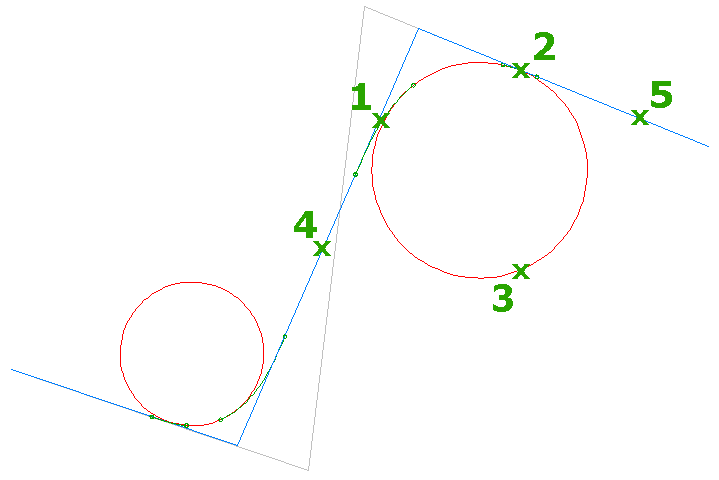Create an alignment that follows the most logical path through a series of feature lines, COGO points, or AutoCAD lines, arcs, points, or blocks.
You can adjust the command to obtain the desired results based on the type and the accuracy of the source data.
For example, when you use COGO points as source data, Autodesk Civil 3D determines the most logical sequence of the COGO points, and then reverses the order of any that do not correspond to the sequence of the other selected COGO points.

When two paths of roughly parallel COGO points are used, an AutoCAD spline (1, 2) is created through each path of points. The points from each spline are projected onto the other spline; points where the two projections meet are used to create the centerline (3).

Next, Autodesk Civil 3D calculates curves (1) based on the sequence of the points and the specified Maximum Radius For Curve Detection setting. Autodesk Civil 3D approximates the curvature by linking the sample points together with linear segments. To increase the accuracy when using either feature lines or AutoCAD entities, intermediate sample points may be either weeded from the original input data or created between each pair of sample points. When a sequence of points has a radius that is greater than this setting, the points will form a tangent (2). The apparent intersection of the tangents (3) are the points of intersection for the alignment tangents.

When the Create Spirals option is selected, Autodesk Civil 3D creates a symmetrical pair of spirals (1) between each curve and its tangents. If spirals that meet the specified R/A value do not fit between the tangents (2) and the curve (3), then the curve radius is reduced (4) until a solution is found. When you specify this option without the Create Spirals and Match Tangents Where Possible option, the spirals will be symmetrical, but the solution may have greater error.

When the Create Spirals and Match Tangents Where Possible option is selected, Autodesk Civil 3D creates an asymmetrical pair of spirals (1, 2) between each curve (3) and its tangents (4, 5). If a spiral that meets the specified minimum R/A ratio does not fit between a curve and a tangent, then the tangent (4) is moved toward the curve until a solution is found. The minimum R/A value enables you to restrict the spiral lengths; a higher value produces shorter spirals, while a lower value produces longer spirals.
